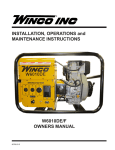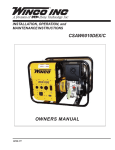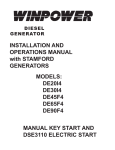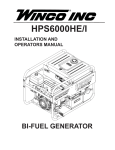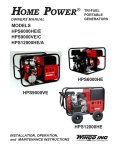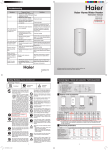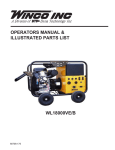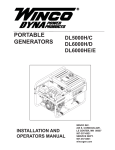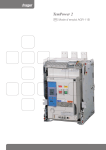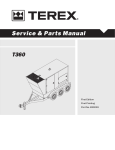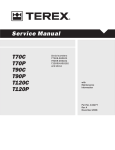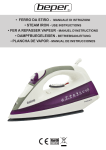Download Winco W6010DE Operating instructions
Transcript
INDUSTRIAL PORTABLE INSTALLATION AND OPERATORS MANUAL W6010DE/G WINCO INC. 225 S. CORDOVA AVE. LE CENTER, MN 56057 507-357-6821 SERVICE DEPT. 507-357-6831 wincogen.com SAVE THESE INSTRUCTIONS PROPER USE AND INSTALLATION This manual contains important instructions that should be followed during installation and maintenance of the generator and battery. Read and understand all instructions in the manual before starting and operating the generator set. You must be sure your new engine generator set is: * Properly serviced before starting. * Operated in a well ventilated area. * Properly exhausted and gases safely dispersed. * Operated only for its designed purposes. * Used only by operators who understand its operation. * Properly maintained. USING THE MANUAL Congratulations on your choice of a Winco generator set. You have selected a high-quality, precision engineered generator set designed and tested to give you years of satisfactory service. COPY YOUR MODEL AND SERIAL NUMBER HERE No other WINCO generator has the same serial number as yours. It is important that you record the number and other vital information here. If you should ever need to contact us on this unit it will help us to respond to your needs faster. To get the best performance from your new engine generator set, it is important that you carefully read and follow the operating instructions in this manual. Should you experience a problem please follow the “Troubleshooting Tables” near the end of this manual. The warranty listed in the manual describes what you can expect from WINCO should you need service assistance in the future. MODEL W6010DE/G SERIAL NUMBER_________________________ TABLE OF CONTENTS INTRODUCTION BASIC INFORMATION Specifications SAFETY INFORMATION SPECIFICATIONS UNIT CAPABILITIES PREPARING THE UNIT Unpacking the Unit Unit Preparation Battery Installation OPERATION/INSTALLATION INITIAL START UP Manual Starting Electric Starting Operating Speed CONNECTING THE LOADS Wiring ENGINE CARE GENERATOR CARE TROUBLESHOOTING GENERATOR TESTING RESISTANCES ENGINE MAINTENANCE PARTS CONTROL PANEL WIRING DIAGRAM WARRANTY INFORMATION 60706-245 PURCHASE DATE_________________________ 2 DEALER_________________________________ 2 3 4 5 DEALER PHONE # ________________________ 6 6 7 8 8 8 8 9 9 9 10 13 14 14 14 15 16 2 4150-00 proper use. Fire extinguishers rated ABC by NFPA are appropriate. e. Store fuel only in an approved container, and only in a well ventilated area. f. Follow local codes for closeness to combustible material. SAFETY INFORMATION This engine generator set has been designed and manufactured to allow safe, reliable performance. Poor maintenance, improper or careless use can result in potentially deadly hazards; from electrical shock, exhaust gas asphyxiation, or fire. Please read all safety instructions carefully before installation or use. Keep these instructions handy for future reference. Take special note and follow all warnings on the unit labels and in the manuals. 3. DEADLY EXHAUST GAS Exhaust fumes from any gasoline engine contain carbon monoxide, an invisible, odorless and deadly gas that must be mixed with fresh air. a. Operate only in well ventilated areas. b. Never operate indoors including attached garages c. Never operate the unit in such a way as to allow exhaust gases to seep back into closed rooms (i.e. through windows, walls, floors). ANSI SAFETY DEFINITIONS ******************************************************* DANGER: DANGER indicates an imminently hazardous situation which, if not avoided, will result in death or serious injury. This signal word is to be limited to the most extreme situations. *********************************************************** 4. NOISE HAZARD Excessive noise is not only tiring, but continual exposure can lead to loss of hearing. a. Use hearing protection when working around this equipment for long periods of time. b. Keep your neighbors in mind when using this equipment. WARNING: WARNING indicates a potentially hazardous situation which, if not avoided, could result in death or serious injury. *********************************************************** 5. CLEANLINESS Keep the generator and surrounding area clean. a. Remove all grease, ice, snow or materials that create slippery conditions around the unit. b. Remove any rags or other materials that could create a potential fire hazard. c. Carefully clean up any gas or oil spills before starting the unit. CAUTION: CAUTION indicates a potentially hazardous situation which, if not avoided, may result in minor or moderate injury. It may also be used to alert against unsafe practices. *********************************************************** 1. ELECTRICAL SHOCK The output voltage present in this equipment can cause fatal electric shock. This equipment must be operated by a responsible person. a. Do not allow anyone to operate the generator without proper instruction. b. Guard against electric shock. c Avoid contact with live terminals or receptacles. d Use extreme care if operating this unit in rain or snow. e. Use only three-pronged grounded receptacles and extension cords. f. Be sure the unit is properly grounded to an external ground rod driven into the earth. 6. SERVICING EQUIPMENT All service, including the installation or replacement of service parts, should be performed only by a qualified technician. a. Use only factory approved repair parts. b. Do not work on this equipment when fatigued. c. Never remove the protective guards, covers, or receptacle panels while the engine is running. d. se extreme caution when working on electrical components. High output voltage from this equipment can cause serious injury or death. e. Always avoid hot mufflers, exhaust manifolds, and engine parts. They can cause severe burns instantly. f. The use of the engine-generator set must comply with all national, state, and local codes. 2. FIRE HAZARD Diesel fuel and other fuels present a hazard of possible explosion and/or fire. a. Do not refuel when the engine is running or hot. b. Keep fuel containers out of reach of children. c. Do not smoke or use open flame near the generator set or fuel tank. d. Keep a fire extinguisher nearby and know its 4150-00 3 60706-245 SPECIFICATIONS TESTING POLICY MODEL Generator Surge Watts Continuous Watts Volts AMPs @ 240 Volts AMPs @ 120 Volts 6000 5500 120/240 22.9 45.8 Before any generator is shipped from the factory, it is fully checked for performance. The generator is loaded to its full capacity, and the voltage, current and frequency are carefully checked. Engine Size Model Type Fuel CapacityFuel Consumption Starting System Muffler Stop System 9.9 HP Yanmar L100V See Engine Shroud For 7 gal .7 gal/hr 12 Volt Electric/Key Low Tone Key W6010DE/G Rated output of generator is based on engineering tests of typical units, and is subject to, and limited by, the temperature, altitude, fuel, and other conditions specified by the manufacturer of the applicable engines. INTENDED USES This engine generator set has been designed primarily for portable heavy duty commercial use. Both 120 volt and 240 volt receptacles are provided in the control panel to plug in your loads (lights, portable tools, and small appliances). This portable unit requires large quantities of fresh air for cooling the engine and generator. For safety, long life and adequate performance, these units should never be run in small compartments without positive fresh air flow. Complete Unit Weight (dry) 288 LBS Dimensions LxWxH 32 X 22 X 23 RESTRICTED USES Owner Must Provide Fuel #2 Diesel Oil Type 10W-30 CD or higher for -4F to 80F See engine manual for additional oil information. Oil Capacity 1.7 Qts (1.6 L) DO NOT remove from the cradle assembly. Removal of the generator from the cradle assembly may cause excessive vibration and damage to the engine-generator set. DO NOT install and operate this generator in a small compartment., i.e. generator compartments of vehicles, motor homes or travel trailers. These compartments will not allow enough free flow of fresh air to reach the engine generator set for cooling and will cause the unit to overheat, damaging both the engine and generator. Small compartments will also develop hot spots where there is very little air flow and may cause a fire. PLEASE NOTE There are 3rd party companies making enclosures for generators that have been properly engineered. The use of these 3rd party enclosures is acceptable as long as they have been certified and meet current code. DO NOT attempt to operate at 50 cycles. These units are designed and governed to operate at 60 cycles only. 60706-245 4 4150-00 UNIT CAPABILITIES HP This generator is equipped with Switchless Full Power. This feature allows the full output of the unit to be drawn from either the 120 volt receptacles or the 240 volt receptacle without reconnecting the generator. This feature is extermly helpful when powering larger 120 volt loads. The diagram below represents the 5500 watt (rated output) generator 1/6 1/4 1/3 1/2 1 RUNNING AMPS 3.2 4.5 5.2 7.2 13.0 SP STARTING AMPS CAP 16 TO 22 22 TO 32 26 TO 35 NOT MADE NOT MADE RI 6 TO 13 5 TO 8 9 TO 18 7 TO 12 10 TO 21 8 TO 17 14 TO 29 11 TO 18 26 TO 52 20 TO 33 The figures given above are for an average load such as a blower or fan. If the electric motor is connected to a hard starting load such as an air compressor, it will require more starting current. If it is connected to a light load, or no load such as a power saw, it will require less starting current. The exact requirement will also vary with the brand or design of the motor. Self-excited generators respond to severe overloading differently than the utility power. When overloaded, the engine is not able to supply enough power to bring the electric motor up to operating speed. The generator responds with high initial starting current, but the engine speed drops sharply. The overload may stall the engine. If allowed to operate at very low speeds, the electric motor starting winding will burn out in a short time. The generator winding might also be damaged. CAUTION: EQUIPMENT DAMAGE Reference A = 120 Volt Full Power Receptacle NEMA 5-50 (120V-50A) Reference B & C = 120 Volt Receptacle B - NEMA 5-20 (120V-20A) C - NEMA 5-20 (120V-20A) Reference D = 120/240 Volt Twistlock Receptacle NEMA L14-30 (120/240V-30A) RUNNING THE GENERATOR SET UNDER THESE CONDITIONS MAY RESULT IN DAMAGING THE GENERATOR STATOR AS WELL AS THE MOTOR WINDING. Because the heavy surge of current required for starting motors is required for only an instant, the generator will not be damaged if it can bring the motor up to speed in a few seconds of time. If difficulty is experienced in starting motors, turn all other electrical loads off and if possible reduce the load on the electric motor. With the receptacles wired in this configuration the operator can use up to the nameplate rating of unit (5500 Watts) using any combination of the 120 Volt receptacles and still have the 240 volt power available. Remember no matter what combination of 120 volt or 240 volt power utilized you can not exceed the 5500 watt rating of the unit.. Motor Starting Capacity - listed below you will find the motor starting capability of your engine generator set. Starting Electric Motors - Electric motors require much more current (amps) to start them than to run them. Some motors, particularly low cost split-phase motors, are very hard to start and require 5 to 7 times as much current to start them as to run them. Capacitor motors are easier to start and usually require 2 to 4 times as much current to start them as to run them. Repulsion Induction motors are the easiest to start and usually require 1 1/2 to 2 1/2 times as much to start them as to run them. Generator Motor Size Model (code “G” capacitor start) W6010DE 3.0 HP Trying to start a larger motor or higher code (ie. J or K) motor may result in damage to both the generator and the electric motor especially 120 volt motors. Most fractional horsepower motors take about the same amount of current to run them whether they are of Repulsion-Induction (RI), Capacitor (Cap), or Split-Phase (SP) type. The chart below shows the approximate current required to start and run various types and sizes of 120 volt 60 cycle electric motors under average load conditions. 4150-00 5 60706-245 CAUTION: EQUIPMENT DAMAGE 1. Lubrication - Before starting the engine, fill the crankcase to the proper level with a good quality oil. The recommended grade of oil and quantity of oil required is listed below. The necessity of using the correct oil, and keeping the crankcase full cannot be overemphasized. Engine failures resulting from inadequate or improper lubricant are considered abuse and are not covered by the generator or the engine manufacturers warranty. THIS UNIT HAS BEEN SHIPPED WITHOUT OIL. Failure to maintain the engine oil at the proper level will result in serious engine damage. UNPACKING When you unpack your new ENGINE GENERATOR, be sure to remove all the information sheets and manuals from the carton. a. b. 1. This power plant was in good order when shipped. Inspect the power plant promptly after receiving it. If damage is noted, notify the transportation company immediately; request proper procedures for filing a “concealed damage” claim. Title to the equipment and responsibility for filing claim rests with you when a generator is sent F.O.B. Shipping point. Only you can legally file a claim. Make sure the engine is level Remove the oil cap/dipstick (1) from either side of the engine and wipe off with a clean cloth. Fully re-insert oil cap/dipstick, but do not screw c. in. d. Remove oil cap/dipstick. The oil level should be between the upper mark (2) and the lower mark (3) on the oil cap/dipstick. e. Fill engine with proper grade and weight of oil. f. Fully reinsert oil cap/dipstick and hand tighten. Over-tightening the oil cap/dipstick will damage it. g. Never overfill. Overfilling may result in white exhaust smoke, engine overspeed or internal damage 2. Before proceeding with the preparation of your new engine generator set for operation, take a couple of minutes to insure that the unit you have received is the correct model and review the specification pages in this manual to insure that this unit fits your job requirements. Oil should be change after the first 50 hours of operation and every 200 hours there after. It should be checked daily. 3. After removing the engine generator from the carton locate and remove the shipping strap attached to the generator shock mount. See attached tag for removal instructions. UNIT PREPARATION Before your engine generator was shipped from our factory it was fully checked for performance. The generator was load tested to its full capacity, and the voltage and frequency were carefully checked and adjusted. YANMAR recommends A. P. I. engine service classification of CD or higher oil. Always use oil with the right viscosity or the ambient temperature in which your engine is being operated. USE the chart above when choosing you engine oil. The YANMAR engine operators manual has addition information on oil requirements. 2. Diesel Fuel - Always use a good grade of # 2 diesel fuel. For cold weather, blended # 1 fuel may be used Fuel cetane number should be 45 or higher and the fuel MUST be low sulfur or ultra low sulfur fuel. See engine operators manual for additional fuel recommendations including Bio-Diesel fuel. Never use gasoline or gasohol. Always insure that the fuel is clean and free of all impurities. Always be sure to keep the strainer in place when filling the fuel tank. 60706-245 6 4150-00 CAUTION - DO NOT open or mutilate the battery. Released electrolyte is known to be harmful to the skin and eyes and to be very toxic. WARNING: FIRE Diesel fuel is flammable and can be ignited to cause or enlarge fires when proper precautions are not taken. These engine generator sets are all NEGATIVE ground. Be very careful not to connect the battery in reverse polarity, as this may short circuit the battery charging system on the engine. Never use fuel that has been stored for an extended period of time. Fuel will lose its volatile properties and you will be left with a ‘gum’ / varnish residue. This varnish-like substance will clog the filters, fuel lines and injectors. Old, contaminated, stale fuel will not burn properly. The use of a fuel additive, such as STA-BIL, or an equivalent will minimize the formation of fuel gum deposits. If a unit has been out of operation for an extended period of time, it is best to drain old fuel from the engine and replace with fresh fuel before attempting to start. CAUTION – A battery presents a risk of electrical shock and high short circuit current. The following precautions must be observed when working with batteries. 1. Remove watches, rings and other metal objects. 2. Use tools with insulated handles. 3. Check both the battery cable ends and the battery posts to be sure they are free of corrosion. 4. Always connect the battery positive cable first and then connect the battery negative cable. When removing the battery cables from the battery reverse the procedure, disconnect the negative cable first and then the positive cable. 5. Be sure all connections are tight and coat the terminals and cable end with dialectic grease. INSTALLING THE BATTERY A customer supplied twelve-volt battery is required to complete the installation. The battery rack on this unit is designed to handle a U1 12 Volt battery, minimum 300 CCA. Installation of the highest CCA rated battery, within the correct BCI group, will increase cold weather starting performance. WARNING – The electrolyte is a diluted sulfuric acid that is harmful to the skin and eyes. It is electrically conductive and corrosive. The following precautions must always be taken. * * * * Installation and servicing of batteries must be performed or supervised only by personnel knowledgeable of batteries and the required precautions. Keep unauthorized personnel away from batteries. DANGER – Explosive Fire Risk * * * When installing or replacing batteries, use the proper group/size starting battery. The battery should be a Maintenance Free lead acid design. Deep cycle batteries will not work for this application. Never smoke when near batteries. Do not cause a flame or spark in the battery area. Always discharge static electricity from your body before touching batteries by first touching a grounded metal surface. SERVICING BATTERIES CAUTION – PERSONAL DANGER Batteries used on these units may over time lose water. This is especially true if you are using a trickle charger to maintain your battery. When refilling the battery with water use only distilled water. Tap water will shorten the service life of the battery. CAUTION - NEVER dispose of a battery in a fire. The battery is capable of exploding. 4150-00 Always wear full eye protection and protective clothing. Where electrolyte contacts the skin, wash off immediately with water. If electrolyte contacts the eyes, flush thoroughly and immediately with water and seek immediate medical attention. Spilled electrolyte is to be washed down with an acid neutralizing agent. A common practice is to use a solution of one pound of bicarbonate of soda (baking soda) to one gallon of water. The bicarbonate of soda solution is to be added until the evidence of reaction, foaming, has ceased. The resulting liquid is to be flushed with water and the area dried. 7 60706-245 1. Manual starting - Provision for manual starting is not provided - If the battery is dead or defective, recharge or replace it. Refer to the engine manual for additional starting, operating, and stopping instructions. Never fill the battery above the fill line. Over filling above the upper level line may cause the electrolyte to overflow, resulting in corrosion to the engine or nearby parts. Immediately wash off any spilled electrolyte following the procedure above. Note: The recoil can be used to assist in starting a unit with a weak battery- but the battery must be strong enough to pull in the fuel soleniod. NOTE: Always make sure that a new battery is fully charged before installing it on a generator set. 2. Electric Starting - Always keep the battery charged, but especially during cold weather operation. All connections must be clean and tight. Check the electrolyte (fluid) in the battery periodically to be sure it is above the plates. Never allow the battery to remain in a discharged condition. a. Turn on the fuel supply and prime the fuel line up to the injector pump. b. Operate the key switch. Position #I will turn on the fuel solenoid and position #II will engage the Starter. The switch is spring loaded to the #I position, so when you release the key the switch returns to this position. INSTALLING THE EXHAUST DEFLECTOR c. The engine will start and come up to operating speed. d. To shut the unit off rotate the key switch to the O position and the unit is stopped by shutting off the fuel solenoid. The exhaust deflector shown above was shipped loose with your unit. It is installed by sliding it over the exhaust pipe coming out of the muffler and tightening the locking ring. The exhaust can be direct in any direction. OPERATION/INSTALLATION This engine generator set consists of a Yanmar 9.9 hp diesel engine and a 6 kw generator end. The Yanmar engine is an electric key start engine with low oil level protection INITIAL START UP This engine has one additional emergency stop lever mounted on the side of the engine below the electric fuel solenoid. If this lever is tripped to the stop position it must be manually reset before the engine can be started. To reset, move the lever (1) back to the run position. This lever and associated mounting brackets also set your engine speed, so no adjustment should ever be made to this speed control/emergency stop device. Use the following checklist to verify the correct preparation of the engine generator before starting. D Engine oil, fill as required with correct grade and quantity. D Fuel level, fill as required with clean fresh fuel. D Visually check unit for loose parts. STARTING and STOPPING The throttle control on these generators is preset and locked to operate at 3600 RPM (nominal) with no load speed set at 3690 RPM. Only a trained service technician should be allowed to adjust this speed setting. See “Operating Speed” section for additional information. 60706-245 8 4150-00 LOAD vs. OUTPUT ************************************************************** Generator Frequency Generator voltage Load Speed (Hz) 120V 240V Applied* (RPM) Recpt. Recpt. ———————————————————————— None 3690 61.5 129V 258V Half 3600 60.0 120V 240V Full 3510 58.5 115V 230V ************************************************************** *Portion of plant’s rated output current. The speed of the engine was carefully adjusted at the factory so that the generator produces the proper voltage and frequency. For normal usage, the speed setting should not be changed. If the generator is being run continuously on a very light load, it is often advisable to lower the operating speed slightly. Whenever making any speed adjustments check the unit with a voltmeter or tachometer and be sure the speed is correct. STARTING HINTS Cold Weather 1. Use the proper oil for the temperature expected. 2. Use fresh winter grade fuel. Winter grade fuel is blended to improve starting. Do not use old or straight summer blend fuel. CAUTION: EQUIPMENT DAMAGE Never use ether or any other starting aides. Serious engine damage or personal injury may result from ignoring this simple warning. Hot Weather 1 Use the proper oil for the temperature expected. 2. Use only summer blended fuel. Using old fuel left over from winter may cause damage to the engine or clogging of the fuel filters and injection pump. See Engine Manufacturers instructions. The engine will govern itself at full speed. Intentionally overriding the governor and operating the generator at low voltage may damage both the generator and any load connected to it. Running the engine at excessively high speeds results in high voltage, which may significantly shorten the life of light bulbs and appliances being used, as well as possibly damaging the engine. OPERATING SPEED The engine-generator must be run at the correct speed in order to produce the proper electrical voltage and frequency. Output voltage should be checked periodically to ensure continued proper operation of the generating plant and appliances. If the generator is not equipped with a voltmeter, it can be checked with a portable meter. Frequency can be checked by using an electric clock with a sweep second hand. Timed against a wrist watch or a stop watch the clock should be correct within +/- 2 seconds. CAUTION: EQUIPMENT DAMAGE The output voltage should be checked to insure the generator is working properly prior to connecting a load to the generator. Failure to do so could result in damage to equipment plugged into the unit and possible injury to the individual. CONNECTING THE LOADS The engine-generators covered in this manual were designed for portable use. DO NOT OPERATE INDOORS. The unit should be stored in a warm dry location. Move the unit outdoors to a flat dry location for use. All engines have a tendency to slow down when a load is applied. When the electrical load is connected to the generator, the engine is more heavily loaded, and as a result the speed drops slightly. This slight decrease in speed, together with the voltage drop within the generator itself, results in a slightly lower voltage when the generator is loaded to its full capacity than when running no load. The slight variation in speed also affects the frequency of the output current. This frequency variation has no appreciable effect in the operation of motors, lights and most appliances. However, electronic equipment and clocks will be affected if correct RPM is not maintained. See Load vs. Output chart. Applying The Load Allow the engine to warm up for two or three minutes before applying any load. This will allow the engine to reach normal operating temperature and oil to circulate throughout the engine. A short warm-up time will permit the engine to work more efficiently when the load is applied and will reduce the wear in the engine, extending its life. Receptacles have been provided to allow loads to be connected to the generator. The loads should be added one at a time. If a large motor is being started or multiple motors are being started, they should be started individually and the largest should be started first. Although individual units and models may vary slightly, the normal voltage and frequency of the engine-generators described in this book are approximately as follows, under varying loads: 4150-00 9 60706-245 CAUTION: EQUIPMENT OVERLOAD WARNING: PERSONAL DANGER Keep the generator load within the generator and receptacle nameplate rating. Overloading may cause damage to the generator and/or the loads . A fully isolated, double pole double throw manual transfer switch must be installed any time a generator is being connected to an existing distribution system. Most electric tools and appliances will have the voltage and amperage requirements on their individual nameplates. When in doubt consult the manufacturer or a local electrician. The nameplate amperage rating for electric motors can be misleading. See “Starting Electric Motors” in Unit Capabilities (page 5). 1. These engine generator sets are designed for portable heavy duty commercial use. A 4 wire receptacle (2 hot, 1 ground, and 1 neutral) has been provided on the control panel for use in temporary power applications requiring 120/240 volt power. Consult a licensed electrician for wiring the TemPower plug and connecting it as temporary service. These engine generator sets are inherently self regulating based on engine speed. The engine governor will automatically adjust itself to the load. No harm to the generator will result if it is operated for short periods of time with no load connected to warm it up. CAUTION: EQUIPMENT DAMAGE Diesel engines should never be run for an extended period of time with a very light load or no load on them, it may do permanent damage to the engine if run under these conditions. Proper utilization of the receptacles located on the control panel is necessary to prevent damage to either the receptacles or the generator. The generator is a limited source of electrical power, therefore pay special attention to the receptacle and generator ratings. The nameplate rating can be obtained through a single receptacle as long as the receptacle amperage rating is not exceeded. Grounding All units must be grounded. Drive a 3/4 or 1” copper pipe or rod into the ground close to the engine-generator set. The pipe must penetrate moist earth. Connect an approved ground clamp, to the pipe. Run a no. 10 Awg wire from clamp to the generator ground lug on the “receptacle panel”. Do not connect to a water pipe or to a ground used by a radio system. WIRING Plug your tools such as drills, saws, blowers, sump pump and other items to be powered directly into the generator receptacles. Before plugging in all the tools and cord sets, recheck the rating of the generator set. Be sure it can handle the intended load and is compatible with the voltage, phase, and current ratings. ‘Hard Wiring’ this unit directly into a temporary construction site electrical system is NOT A SIMPLE DO-IT-YOURSELF JOB. For your safety all wiring must be done by a qualified electrician and conform to the National Electric Code and comply with all state and local codes and regulations. Check with local authorities before proceeding. 60706-245 To connect these units directly to an un-powered, isolated construction site TemPower panel, have your electrician connect to the control panel using a 120/240 volt, four wire twist-lock plug (L14-30P). The use of locking receptacles and locking plugs provides the convenience of quick disconnect, for moving, while allowing non electrical workers to safely reconnect the power. In addition they prevent the plug from being accidentally removed by bumping or vibration. 2. If the generator set is be connected to existing distribution system a fully isolated manual transfer switch must be installed. The transfer switch prevents damage to the generator and other circuit components if main line power is restored while the generator is connected. Installing a transfer switch also permits the use of normal fusing. 3. Many homes and construction sites are wired for at least 60 to 100 Amp entrance service, much greater than the capacity of these portable generators. When installing the generator at these sites, a secondary emergency distribution panel may have to be installed, such as the Emergency Transfer/Service (ET/S) system available through your WINCO dealer. The emergency distribution panel must be installed by a licensed electrician according to all applicable codes. The electrician will move the critical circuits to be powered during the outage to the emergency panel. Keep in mind only a limited amount of amperage is available from the generator set. Some circuit breakers may still have to be turned off to prevent an overload on the generator during the initial start up. See the nameplate on your generator for the amperage capabilities of your unit. CAUTION: EQUIPMENT DAMAGE Failure to properly limit and balance the load applied to the generator will cause the generator to produce low voltage and may damage the engine generator set. It may also cause severe damage to the loads connected to the generator at that time. Improper loading of the generator set constitutes abuse and will not be covered by warranty. 10 4150-00 ENGINE CARE If major engine service or repair is required contact an authorized engine service center. The manufacturer of these engines has established an excellent worldwide engine service organization. A listing of service centers is included with the engine operators literature package. Engine service is very likely available from a nearby authorized 4150-00 dealer or distributor. Check the yellow pages of your local telephone directory under “Engines-Diesel” for the closest engine repair center or ask the dealer from whom you purchased the power plant. You can also locate a engine service center by accessing the Winco web site at www. wincogen.com, click on Service Support and then engine support. Page down to Yanmar engine and access their web site and dealer locator. 11 60706-245 1. CHANGING THE OIL Before refilling the engine with oil, the oil filter must be remove and cleaned or replaced. Change the oil as recommended in the engine operators manual. It is usually required to change oil after the first 50 hours of operation and every 200 hours thereafter under normal operating conditions. If the engine is not used frequently, change the oil every 12 months, regardless of the actual number of hours of operation. a. Remove the oil filter retaining bolt (1). b. Pull the oil filter cap (2) out and remove the oil filter (3). c. Clean the oil filter or replace if damaged. d. Install the oil filter. e. Make sure the oil filter cap is fully seated (2). f. Install and tighten the oil filter retaining bolt (1). g. Refill the engine with new oil. Run the engine for about 5 minutes checking for any oil leaks. After the engine is warm, shut it off and let it sit for 10 minutes. h. Recheck the oil level in the engine and refill as required. a. Make sure the unit is level. b. Start the engine and bring it up to operating temperature. c. Stop the engine. d. Remove the oil cap/dipstick (1) to allow the engine to drain more easily. Replacement engine oil filter part number 114250-35070 or 114299-35110. 2. Servicing Air Cleaners Check the engine air filer check and cleaned after the first 100 hour of operation and every 200 hour after that. Consult engine operators manual for additional recommendations. Service more often if it isvery dirty. Replace the cartridge using only original equipment parts available at any engine service center. e. Position a container under the engine to collect the old oil. f. Remove the drain plug located on the bottom of the cylinder block (either side) (2). Allow the oil to drain completely. g. After all the oil has been drained from the engine, install the drain plug (2) and tighten to 14-17 ft. lbs. h. Dispose of used oil properly. 60706-245 12 4150-00 a. Remove the wing nut (1). GENERATOR CARE b. Remove the air cleaner cover (2). Proper care and maintenance of the generator is necessary to insure a long trouble free life. c. Remove the wing nut (3). 1. Exercising The Generator - The generator should be operated every three to four weeks. It should be operated for a period of time sufficient to warm the unit up and to dry out any moisture that has accumulated in the windings. If left this moisture can cause corrosion in the winding. Frequent operation of the engine generator set will also insure that the set is operating properly should it be needed in an emergency. d. Remove the air cleaner element (4) and the outer foam element (5). e. Blow air through both elements using 42-71 psi compressed air to remove the particulates. Use the lowest possible air pressure to remove the dust without damaging the elements. f. If either element is damaged replace both of them (they are not sold individually). Replacement element part number is 114210-12590. g. 2. Generator Maintenance - Any major generator service including the installation or replacement of parts should be performed only by a qualified electrical technician. USE ONLY FACTORY APPROVED REPAIR PARTS. Clean the inside of the air cleaner cover (2). a. Bearing - The bearing used in these generators is a heavy duty double sealed ball bearing. They require no maintenance or lubrication. h. Install the air cleaner element (4) into the air cleaner case. Check accurately that the air filter cartridge is properly fitted and aligned with its own seat of the air filter box. b. Receptacles - Quality receptacles have been utilized. If a receptacle should become cracked or otherwise damaged, replace it. Using damaged or cracked receptacles can be dangerous both to the operator and to the equipment. i. Install the wing nut (3) and hand tighten. Overtightening the wing nut will damage the air cleaner assembly. j. Slide the outer foam element (5) over the air cleaner element (4). CLEANING k. Install the air cleaner cover (2). Install the wing nut (1) and hand tighten. Overtightening the wing nut will damage the air cleaner assembly. Remove dirt and debris with a cloth or brush. DO NOT use high pressure spray to clean either the engine or the generator. This high pressure spray could contaminate the fuel system and the generator components. LOW OIL LEVEL SHUTDOWN SYSTEM This low oil warning system will automatically stop the engine before the oil pressure reaches an operational danger point. This feature is designed to prevent costly repairs and downtime. Use of the oil safety shutdown system on applications that are subject to shock, bumping or severe angles of operation (in excess of 15 degrees) should be avoided. This is especially true if an unexpected shutdown would cause a safety hazard or serious inconvenience for the operator. 4150-00 1. Keep the air inlet screen on both the engine and generator free of any dirt or debris to insure proper cooling. At least yearly remove the blower housing on the engine and clean the chaff and dirt out of the engine cooling fins and flywheel. Clean more often if necessary. Failure to keep these areas clean may cause overheating and permanent damage to the unit. 2. Periodically clean muffler area to remove all grass, dirt and combustible debris to prevent a fire. 3. On engine mufflers equipped with spark arresters, the spark arrester must be removed every 50 hours for cleaning and inspection. Replace if damaged. 13 60706-245 TROUBLESHOOTING TABLE GENERATOR SPECIFICATIONS —————————————————————————-PROBLEM (SYMPTOMS) POSSIBLE CAUSES ————————————————————————-— Won’t Start (electric) *Fouled fuel injector. *Out of fuel. *Dead battery. *Defective start switch. *Defective start solenoid. *Defective fuel solenoid. *Defective fuel pump. *Defective control relay ————————————————————————— Voltage too low *Engine speed is too low. *Generator overloaded. *Defective stator. *Defective rotor (field). *Defective capacitor. ————————————————————————— Circuit Breaker Trips *Defective load. *Defective receptacle. *Defective circuit breaker Generator manufacturer Part number Rotor part number Rotor resistance Stator part number Stator resistance G1-N Stator resistance G3-N “Q” winding resistance Rectifier part number WINCO Inc. 15532-009 15522-002 11.5 Ohms 15528-002 0.11 Ohms 0.18 Ohms 0.80 Ohms 91452-000 ENGINE SPECIFICATIONS Engine manufacturer Engine model number Air filter & pre-cleaner Oil filter or Oil capacity Yanmar Diesel L100V6EJ1CHAS1 114210-12590 114250-35070 114299-35110 52 - 54 oz. ————————————————————————— Voltage too high *Engine speed is too high. ————————————————————————— Generator overheating *Overloaded. *Insufficient ventilation. ————————————————————————— No output voltage *Short in load. *Broken or loose wire. *Defective receptacle. *No residual magnetism in generator. *Defective stator. *Defective rotor (field). *Shorted capacitor. *Defective diode. ————————————————————————---- 60706-245 14 4150-00 RECEPTACLE PANEL WIRING DIAGRAM ENGINE WIRING HARNESS 4150-00 15 60706-245 WINCO, Incorporated warrants to the original purchaser for 24 months that goods manufactured or supplied by it will be free from defects in workmanship and material, provided such goods are installed, operated and maintained in accordance with Winco written instructions. WINCO’s sole liability, and Purchaser’s sole remedy for a failure under this warranty, shall be limited to the repair of the product. At WINCO’s option, material found to be defective in material or workmanship under normal use and service will be repaired or replaced. For warranty service, return the product within 24 months from the date of purchase, transportation charges prepaid, to your nearest WINCO Authorized Service Center or to WINCO, Inc. at Le Center Minnesota. THERE IS NO OTHER EXPRESS WARRANTY. To the extent permitted by law, any and all warranties, including those of merchantability and fitness for a particular purpose, are limited to 24 months from date of purchase. In no event is WINCO liable for incidental or consequential damages. Note: Some states do not allow limitation on the duration of implied warranty and some states do not allow the exclusion or limitation of incidental or consequential damages, so the above limitations may not apply in every instance. This warranty gives you specific legal rights which may vary from state to state. WINCO reserves the right to change or improve its products without incurring any obligations to make such changes or improvement on products purchased previously. EXCLUSIONS: WINCO does not warrant Engines. Engines are covered exclusively by the warranties of their respective manufacturers, see enclosed warranties. WINCO does not warrant Batteries, or Other Component Parts that are warranted by their respective manufacturers. WINCO does not warrant modifications or alterations which were not made by WINCO, Inc. WINCO does not warrant products which have been subjected to misuse and/or negligence or have been involved in an accident. This warranty does not include travel time, mileage, or labor for removal or reinstallation of WINCO product from its application. 225 SOUTH CORDOVA LE CENTER, MN 56057 507-357-6831 60706-245 16 4150-00
















